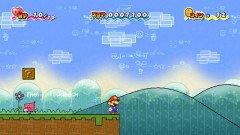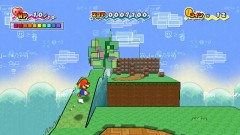If I was to pick a single video game RPG hero as my favorite, Mario would be very close to—or at—the top. Though best known for his platforming adventures, ever since Super Mario RPG: Legend of the Seven Stars first arrived for the SNES, Nintendo’s most famous mascot has also flourished in a very different genre. Super Mario RPG helped pave the way for its primary successor, the N64’s Paper Mario. Along with the handheld-centric Mario & Luigi series, the Paper Mario games are fun, whimsical affairs.
Super Paper Mario is a bit different from Paper Mario, its GameCube sequel Paper Mario: The Thousand-Year Door, and, well, all other Mario RPGs in one crucial way: it’s action-based instead of turn-based, and all of the battles take place directly on the field, a la Kingdom Hearts. Flower Points—which, in the past, were used for special attacks—are done away with entirely; now, most specific moves can be pulled off with the simple press of a button, making battle generally easier than before in this already easy series. Stylish moves make a return, but they aren’t as central to the experience as they were in TTYD. This game is also a lot more platforming-heavy than other Mario RPGs and rewards constant exploration. These changes add up to a very different experience when compared to previous Mario RPGs, but one which suits the source material quite well.

Speaking of exploration, the main feature in Super Paper Mario is the ability to flip the regular “flat” world ninety degrees to reveal a three-dimensional view of that same environment. Often, hidden items, paths, boxes, coins, pipes, and even enemies will appear in a flipped view, making frequent flipping a must if one wants to see as much of the game as possible; however, stay too long in the flipped view, and Mario will start losing HP. Paper Mario has always played around with the idea of two-dimensional objects in three-dimensional spaces, but it is within this third game’s flipping mechanics that the visual whimsy really hits its mark.
Naturally, this inter-dimensional travel is a core theme of the story as well. Mario and Luigi set out to rescue Princess Peach from Bowser, but this otherwise routine mission is complicated by the arrival of Count Bleck, who sets in motion a prophecy that would destroy not just Mario’s world, but all that exist. Now on his own, Mario winds up in a town called Flipside, where he meets the wise man Merlon and the butterfly-shaped Pixl Tippi. From there, he begins his quest to find the Pure Hearts needed to make sure that the dark prophecy doesn’t come to pass, and that a counteracting “light” one does instead. This story is pretty typical fare and a certain segment breaks with the overall pace in an odd way, but it also winds up being the best in the series thus far, thanks in large part to some unexpectedly dramatic turns.

As in most any RPG, Mario travels to a wide range of locales and meets some interesting characters along the way. He also picks up new Pixls, tiny creatures who each enable Mario to use a certain ability; for instance, Tippi can reveal hidden objects and tell the player about an enemy’s attributes. For more abilities (and ever-important healing purposes), several items can be obtained from stores or by defeating monsters; many of these require gimmicky motion-control actions in order to be put to effective use. Finally, there are a few party members that are picked up along the way, each of which can be swapped in to replace Mario at just about any time; none of these newcomers can flip, but they each have a certain crucial ability that Mario and the Pixls lack, and that no item can replicate. In addition to their benefits out on the field, the Pixl and party members’ abilities help in Mario’s exploration of Flipside, and over the course of the game, the number of places available in this hub world slowly grows, sometimes revealing new distractions like a card shop, a restaurant where items can be made into new ones with the help of certain recipes, a 100-floor dungeon, and an arcade where minigames can be played.
Peppered throughout all of this is the humor that has come to be expected from a Mario RPG. In addition to a funny and smartly localized script, there are a handful of cheeky visual references to the Mario platformers of old. Along with its memorable soundtrack and appealing visual aesthetic, all of this is designed to put a smile on any Mario fan’s face.
It isn’t perfect—very few games are—but I can’t recommend Super Paper Mario enough. It’s humorous yet touching, simple yet brilliant, and breezy yet addictive. In spite, yet also because, of its different approaches to gameplay, it shines as one of the best Mario RPGs ever made, and a fantastic game in its own right.